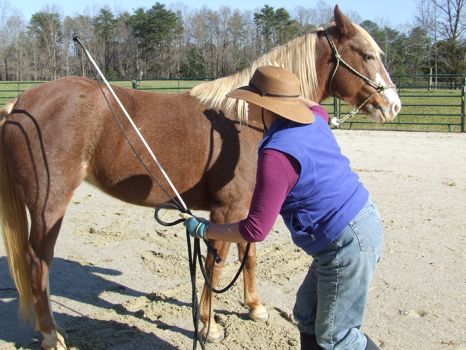A Good Grounding
Part 6: Yield the Hindquarters, Turn on the Fore

Your horse's power and drive come from his hindquarters. If you can get him to disengage them on cue you take away his power to spin, run, buck, bolt, and otherwise make mischief.
The object of this lesson is to get your horse to disengage his hindquarters by moving his hip away from you while stepping his near hind foot over and in front of his far hind foot, pivoting on his far front foot. Watch his feet while conducting this exercise; neither sidestepping nor crossing the near hind foot in back of the far foot constitute a true disengagement of the hindquarters, so these don't count as satisfactory responses.
Stand at your horse's shoulder, facing his rump. Take up the lead line in your near hand, keeping it short, and hold that hand up by your horse's jaw. Holding your hand there will discourage him from stepping forward or into you. Focus your gaze on the point of your horse's hip. Using active body language (lean slightly forward, gaze intently, face the point of his hip squarely) step toward his hip. If he doesn't respond, apply some pressure: tap the air with your stick beside his hip, or twirl the end of your lead line in vertical circles toward his hip with your far hand (the one you're not holding up near his jaw), slowly and gently. Always use rhythmic stick-tapping or lead-twirling cues, and count out the rhythm softly ("one...two...three...") Still no movement? Tap the point of his hip gently with the end of your stick or the end of the twirling rope, again rhythmically while counting out — you're not whipping him here (or ever!), you're just tapping him. Still nothing? Tap harder! Stay rhythmical, and steadily escalate the forcefulness (but not the speed) of your tapping or twirling until your horse's hip begins to move away from you, then reduce the pressure as much as possible while still getting the movement desired. Watch the hind feet: as soon as you get one step with the near hind foot crossing over and in front of the far hind foot, release all pressure until the horse stands still and relaxes, then praise him and rub him affectionately. I like to rub him with the tip of my training stick so that he doesn't develop a fear of it.
Repeat this exercise until you can get two or three steps in a row, then move to the horse's other side and repeat the lesson. Remember that you're dealing with two completely different horses here, Left-Brain and Right-Brain; don't be surprised if 'horse #2' has no idea at first what you want, or is either slower or faster to learn than is 'horse #1'. Build gradually until you are able to move your horse's hindquarters around his fore in a full circle, in both directions, without having to use much pressure and with him truly disengaging his hindquarters with each step.